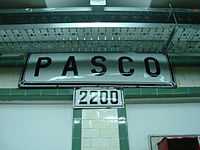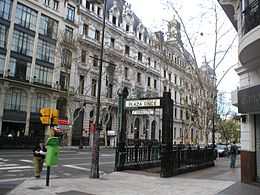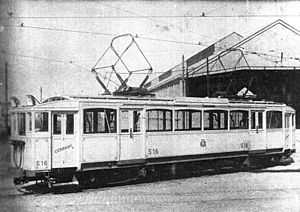Line A (Buenos Aires Underground)
.svg.png) Line A | |||||||||||||||||||||||||||||||||||||||||||||||||||||||||||||||||||||||||||||||||||||||||||||||||||||||||||||||||||||||||||||||||||||||||||||||||||||||||||||||
|---|---|---|---|---|---|---|---|---|---|---|---|---|---|---|---|---|---|---|---|---|---|---|---|---|---|---|---|---|---|---|---|---|---|---|---|---|---|---|---|---|---|---|---|---|---|---|---|---|---|---|---|---|---|---|---|---|---|---|---|---|---|---|---|---|---|---|---|---|---|---|---|---|---|---|---|---|---|---|---|---|---|---|---|---|---|---|---|---|---|---|---|---|---|---|---|---|---|---|---|---|---|---|---|---|---|---|---|---|---|---|---|---|---|---|---|---|---|---|---|---|---|---|---|---|---|---|---|---|---|---|---|---|---|---|---|---|---|---|---|---|---|---|---|---|---|---|---|---|---|---|---|---|---|---|---|---|---|---|---|
|
CNR at "Plaza de Mayo" | |||||||||||||||||||||||||||||||||||||||||||||||||||||||||||||||||||||||||||||||||||||||||||||||||||||||||||||||||||||||||||||||||||||||||||||||||||||||||||||||
| Overview | |||||||||||||||||||||||||||||||||||||||||||||||||||||||||||||||||||||||||||||||||||||||||||||||||||||||||||||||||||||||||||||||||||||||||||||||||||||||||||||||
| Type | Rapid transit | ||||||||||||||||||||||||||||||||||||||||||||||||||||||||||||||||||||||||||||||||||||||||||||||||||||||||||||||||||||||||||||||||||||||||||||||||||||||||||||||
| System | Buenos Aires Underground | ||||||||||||||||||||||||||||||||||||||||||||||||||||||||||||||||||||||||||||||||||||||||||||||||||||||||||||||||||||||||||||||||||||||||||||||||||||||||||||||
| Termini |
Plaza de Mayo San Pedrito | ||||||||||||||||||||||||||||||||||||||||||||||||||||||||||||||||||||||||||||||||||||||||||||||||||||||||||||||||||||||||||||||||||||||||||||||||||||||||||||||
| Stations | 16 | ||||||||||||||||||||||||||||||||||||||||||||||||||||||||||||||||||||||||||||||||||||||||||||||||||||||||||||||||||||||||||||||||||||||||||||||||||||||||||||||
| Daily ridership |
307,188 (2009)[1] | ||||||||||||||||||||||||||||||||||||||||||||||||||||||||||||||||||||||||||||||||||||||||||||||||||||||||||||||||||||||||||||||||||||||||||||||||||||||||||||||
| Operation | |||||||||||||||||||||||||||||||||||||||||||||||||||||||||||||||||||||||||||||||||||||||||||||||||||||||||||||||||||||||||||||||||||||||||||||||||||||||||||||||
| Opening | 1913 | ||||||||||||||||||||||||||||||||||||||||||||||||||||||||||||||||||||||||||||||||||||||||||||||||||||||||||||||||||||||||||||||||||||||||||||||||||||||||||||||
| Operator(s) | Metrovías | ||||||||||||||||||||||||||||||||||||||||||||||||||||||||||||||||||||||||||||||||||||||||||||||||||||||||||||||||||||||||||||||||||||||||||||||||||||||||||||||
| Character | Underground | ||||||||||||||||||||||||||||||||||||||||||||||||||||||||||||||||||||||||||||||||||||||||||||||||||||||||||||||||||||||||||||||||||||||||||||||||||||||||||||||
| Technical | |||||||||||||||||||||||||||||||||||||||||||||||||||||||||||||||||||||||||||||||||||||||||||||||||||||||||||||||||||||||||||||||||||||||||||||||||||||||||||||||
| Line length | 10.7 km (6.65 mi) | ||||||||||||||||||||||||||||||||||||||||||||||||||||||||||||||||||||||||||||||||||||||||||||||||||||||||||||||||||||||||||||||||||||||||||||||||||||||||||||||
| Track gauge | 1,435 mm (4 ft 8 1⁄2 in) | ||||||||||||||||||||||||||||||||||||||||||||||||||||||||||||||||||||||||||||||||||||||||||||||||||||||||||||||||||||||||||||||||||||||||||||||||||||||||||||||
| Electrification | Catenary | ||||||||||||||||||||||||||||||||||||||||||||||||||||||||||||||||||||||||||||||||||||||||||||||||||||||||||||||||||||||||||||||||||||||||||||||||||||||||||||||
| |||||||||||||||||||||||||||||||||||||||||||||||||||||||||||||||||||||||||||||||||||||||||||||||||||||||||||||||||||||||||||||||||||||||||||||||||||||||||||||||
Line A is the oldest line of the Buenos Aires Underground. It runs from Plaza de Mayo to San Pedrito.
Opened to the public on 1 December 1913, the first subway in South America, the Southern Hemisphere and the Spanish-speaking world, it made Buenos Aires the 13th city in the world to have an underground transport service. It stretches 10.5 km from Plaza de Mayo and San Pedrito and runs under all of the Avenida de Mayo and part of the Avenida Rivadavia, and is used by 307,000 people a day.[1] It was extended twice since the completion of the original line in 1914, with the most recent two-station extension—San José de Flores and San Pedrito (formerly Nazca)--entering service on 27 September 2013.
On the first day of public service (December 18, 1913), it carried 220,000 passengers.[2] Line A used the cars used at its inauguration for over a century. These cars were built by Belgian company La Brugeoise starting in 1913 and were refurbished in 1926 when their wooden structure was modified for underground-only use. In 1915 the line was extended to the intersection of Avenidas Lacarra and Rivadavia, where trains ran at street level until 1926. A peculiarity of the original "pantograph" cars on the "underground tramway" is that until 1926 they had both low doors at the ends for boarding from the street and high doors in the middle for loading from platforms in the tunnel. For this reason, Line A might also be considered the continent's first "light rail subway".[3] The old wooden cars were removed in 2013, and replaced by modern cars.
History

During the first decade of the 20th century in Buenos Aires, road traffic had sharply increased due to a growing population. In 1903 the city had 895,381 inhabitants and there were 4,791 horse-drawn carriages and 60 cars, while by 1913 there were 1,457,885 people, with 6,211 carriages and 7,438 automobiles.[4]
Because it was necessary to create new forms of mass transit, in 1909 the Congress awarded Ferrocarril del Oeste (FCO) (Buenos Aires Western Railway) a concession to build a two-way underground railway that would join the main route of the Buenos Aires Western Railway, (currently the Sarmiento Railway) near Sadi Carnot Street (now Mario Bravo) with the port. But on 28 December of that year the Municipality of the City of Buenos Aires gave a concession to the Compañía de Tranvías Anglo-Argentina (CTAA) (Anglo-Argentine Tramways Company), which operated 80% of the tram system at the time - making it perhaps the largest in the world-[5] to build an underground passenger rail service.
After a dispute, it was agreed that the Western Railway would the line for freight, but only with one track at a depth that would allow the passage of the CTAA passenger line on a higher plane. Thus, construction of the Anglo-Argentine Line began on 15 September 1911, with the German company Philipp Holzmann & Cia. as contractor. The construction of this line involved hiring 1,500 workers and used 31 million bricks, 108,000 170 kg bags of cement, 13,000 tonnes of iron braces and 90,000 square metres of insulating layer.
| Plaza de Mayo | |
| Perú | |
| Piedras | |
| Lima | |
| Sáenz Peña | |
| Congreso | |
| Pasco | |
| Alberti | |
| Plaza Miserere | |
| Colour of the friezes in 1913 | |
The Plaza de Mayo-Plaza Miserere subway section was inaugurated on 1 December 1913. On the following day it opened to the public, carrying 220,000 passengers.[2] It was the first subway in South America, the Southern Hemisphere and the Spanish speaking world. Buenos Aires thus became the 13th city in the world to have an underground railway, behind London, Athens, Istanbul, Vienna, Budapest, Glasgow, Paris, Boston, Berlin, New York, Philadelphia and Hamburg. Each station had a length of 100 metres and had friezes of specific colours for easy identification, taking into account the high level of illiteracy that existed at the time.
The construction of the Plaza Miserere station was performed by two companies, CTAA and FCO. At that time the station had two tracks for the railroad in the middle, and two pairs of lines for the underground, which were on the laterals. The outside southern track of the subway was eliminated in 1926 and it was decided to extend the platform to make the rail-underground transfer more convenient.
The route was extended to Río de Janeiro Station on 1 April 1914 and on 14 July of that year to Caballito, renamed Primera Junta in 1923. Beyond Primera Junta a ramp was built in 1915 in the center of Rivadavia Avenue between Cachimayo and Emilio Mitre streets, for trains to access the Polvorín Workshop on Emilio Mitre and José Bonifacio streets, covering a surface loop shared with streetcar traffic until 1963. This 2 km route has been used since 1980 by Asociación Amigos del Tranvía (Association of Friends of the Tram) to run the Buenos Aires Historical Tramway. The ramp was also used by surface passenger to the intersection of Lacarra and Rivadavia Avenues, a service that was canceled on 31 December 1926.
The investment to build the line was m$n 17 million. m$n 3 million was invested in the excavation of the tunnel, m$n 7 million in construction, m$n 2.5 million in the initial 50 trains and m$n 2 million for the Polvorín Workshop.[4][6][6]
In 1997 the Plaza Miserere station was declared a national historic monument.[7] In December 2008, Puan and Carabobo stations were opened, while later in September 2013, the San José de Flores and San Pedrito stations were opened.[8]
Chronology
- 1 December 1913: the Line is inaugurated between Plaza de Mayo and Plaza Miserere.
- 1 April 1914: extended to Río de Janeiro.
- 1 July 1914: extended to Caballito (renamed Primera Junta in 1923).
- 17 February 1939: the line obtained its current name, Line A.
- 1953: Pasco Sur and Alberti Norte were closed, leaving Pasco and Alberti with just one platform each.
- 22 December 2008: extended to Carabobo.
- 27 September 2013: extended to San Pedrito.
Rolling stock


After 96 years of continuous service, the La Brugeoise cars were nearing their final withdrawal from service in 2009. Spare parts for these trains were no longer available on the market so they had to be custom-made by request at Polvorín workshop, where La Brugeoise units and other Buenos Aires Underground rolling stock are maintained and repaired by highly skilled and qualified personnel. According to Metrovías, the Buenos Aires Underground private operator, units underwent a routine check-up every 20 days, while every four years heavy maintenance was performed. Despite their 96 years of uninterrupted service, La Brugeoise trains had one of the lowest mechanical failure averages in the network: 19 every 100,000 km.[9]
It was hoped that these surviving vintage formations could continue operating as a tourist attraction on holidays and Sundays, a development that is becoming popular across the world.[9]
By 2013, After 99 years of continuous service, the Brugeoise cars were definitively withdrawn from service on January 12, 2013, 11 months before their 100th anniversary. They were replaced by new CNR rolling stock, which has been slowly introduced as units arrive from China.[10] The original rolling stock has since been maintained, some in exhibition and some being converted to 1500v to run tourist services on the line.[11]
Ghost stations
Two ghost stations exist on the line. These are Alberti Norte and Pasco Sur, which were closed in 1953. Both these stations had a single platform which allowed boarding trains only towards a single direction, while their opposite platforms (located close to each of the ghost stations) remain open as Alberti and Pasco.[12]
Gallery
-

Piedras entrance
-

Original signage -

Avenida de Mayo entrance -
.jpg)
Kiosk on Castro Barros Station
-
_2.jpg)
Construction works c.1912
-

La Brugoise car before conversion
-

A La Brugeoise formation prior to retirement
-

UEC Preston cars were also used on the line
-
.jpg)
Congreso station interior
-
.jpg)
San Pedrito station, the line's most recent addition
See also
- Tram and light-rail transit systems
References
- ↑ 1.0 1.1 Subte récord: ya transporta 1.7 millón de pasajeros por día. Clarín - (Spanish) - Retrieved 2011-01-20
- ↑ 2.0 2.1 Subterráneos de Buenos Aires (Official Page) History of Line A – Retrieved 2010-11-04
- ↑ Los coches de la línea A del subterráneo porteño (Spanish—Information and photographs) – Retrieved 2010-11-05
- ↑ 4.0 4.1 Tejera, Domingo (1993). Subterráneos de Buenos Aires. (Spanish), pgs. 3 and 11.
- ↑ Trams Of Argentina (See section; Transportes de Buenos Aires) – Retrieved 2010-11-30
- ↑ 6.0 6.1 Justo Solsona y Carlos Hunter (1990). La Avenida de Mayo: un proyecto inconcluso (Avenida de Mayo: an unfinished project) – (Spanish) – Solsona - Hunter Librería Técnica – (pps. 254 - 256) - ISBN 950-9575-34-8
- ↑ Decreto 437/97 (Spanish) Retrieved 2010-10-29
- ↑ Macri inauguró San José de Flores y San Pedrito - EnElSubte, September 2013
- ↑ 9.0 9.1 Puesta a punto de los históricos vagones de la línea A, La Nación newspaper, 21 January 2009 (In Spanish—History includes vintage photos and video) – Retrieved 2009-02-04
- ↑ Preadjudican 105 coches a CNR para la línea A - EnElSubte, May 2013
- ↑ Realizan pruebas con Brugeoise reconvertidos a 1500 V en la línea A - EnElSubte, July 2014
- ↑ Las estaciones clausuradas de la línea A - EnElSubte, 24 April, 2014.
External links
| Wikimedia Commons has media related to Line A. |
- Subterráneos de Buenos Aires (Official Page)
- Metrovías S.A. Subte Operator (Official Page)
- Subterráneos de Buenos Aires, A Line
- System map
- La Brugeoise trains in service in Line A (YouTube)
- Buenos Aires Subway Underground Line A (Subte Linea A) (YouTube)
(http://www.clarin.com/ciudades/Abren-San-Jose-Flores-Pedrito_0_1000700011.html)
| ||||||||||||||||||||||||||||||||||||||||||||||||||||||||||||||||||||||||||||||||||||||||||||||||
| ||||||||||||||||||
